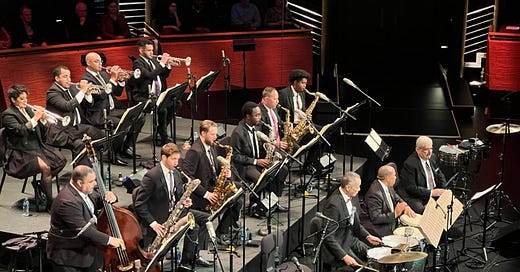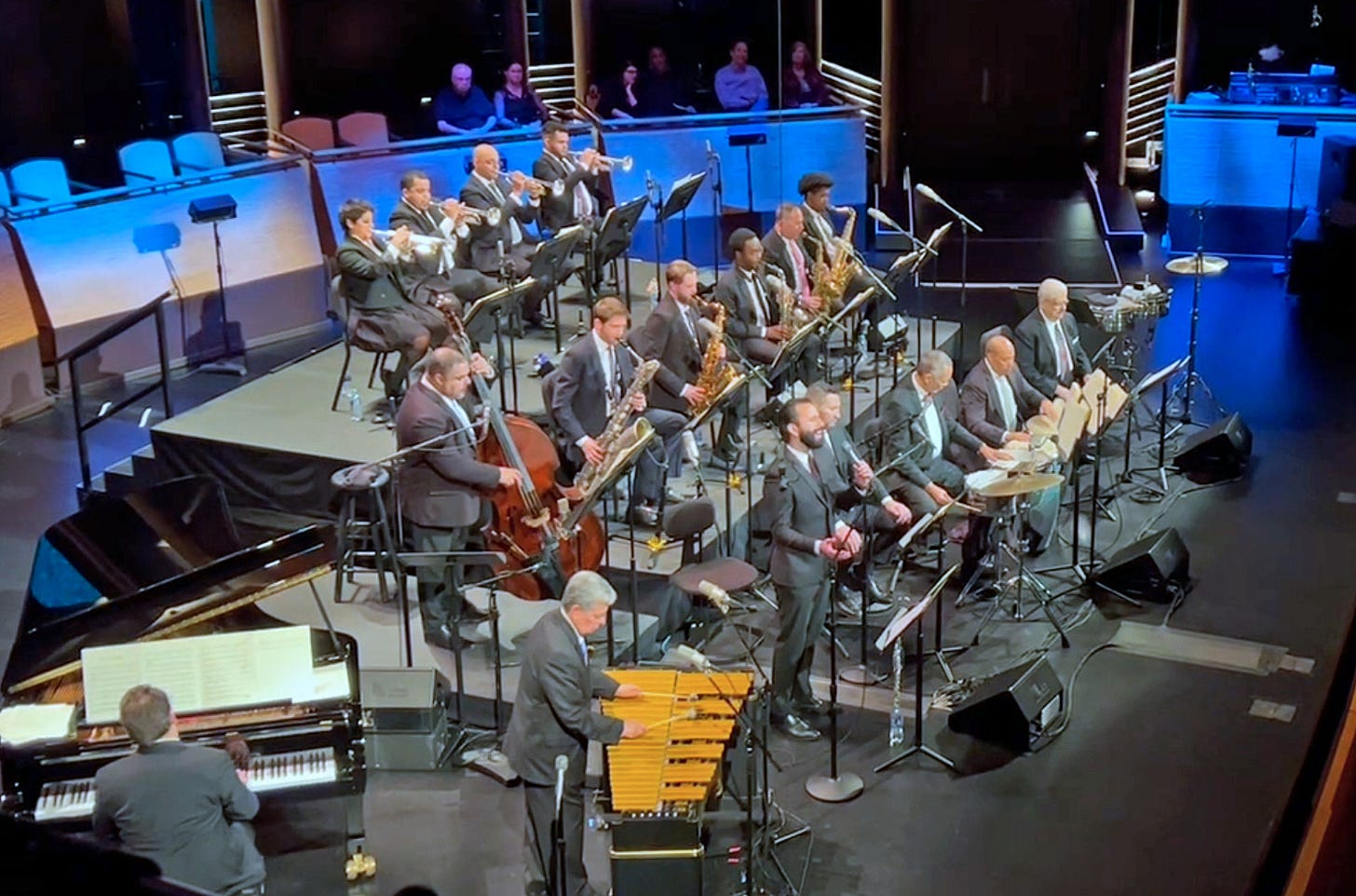This is the third of three pieces I wrote for the New York Sun that somehow never ran. Come to think of it, they all seem to be from the first week of May, which seems to have been an extraordinarily busy week in the city’s vibrant music scene. Anyhow, here’s hoping you will enjoy a two month-old concert review; as it happens, this was an extraordinary concert.
Carlos Henriquez and Friends
“Tito Puente & Tito Rodriguez Centennial Celebration”
Jazz at Lincoln Center (May 5, 2023)
“I know everyone feels like dancing. It’s going to happen, so don’t be afraid. If it does, let it happen, and then just sit down.” So said Carlos Henriquez after the first number, “Satin and Lace” of Jazz at Lincoln Center’s Friday May 5th concert, “Tito Puente & Tito Rodriguez Centennial Celebration.” He was right.
There are at least two things that make Afro Latin big band music different from other kinds of jazz. The first, as Señor Henriquez announced, is the irresistible urge to dance, even among rapidly aging bald white dudes who have absolutely zero terpsichorean skills.
The second is that the music continues to exceed the capabilities of recording technology. Even though masters like the great Afro Cuban orchestras, especially the two centennial celebrants, vocalist-bandleader Tito Rodriguez (1923-1973) and percussionist-composer-arranger Tito Puente (1923-2000) were documented in the latest hi-fi and eventually digital recording processes of their day, there’s still no recording that quite captures the excitement, the color, the rhythm, the high-octane orchestral fireworks of this music the way it sounds in person - especially in a sonically perfect space like JALC’s Rose Hall.
During this truly international season of Jazz at Lincoln Center, we’ve seen a little bit less of the institution’s celebrated orchestra and more of specialized ensembles. For this celebration of two of the greatest names in Latin Jazz, both named Tito and both born one hundred years ago, Señor Henriquez assembled a deluxe latinx orchestra that was actually relatively compact by the standards of the music: four trumpets, five saxophones, the leader on bass, and the expert pianist Manuel Valera. There were no trombones - if I had only been listening and not looking, I might never have noticed, In addition, but there were seven players, some of them special guests, on vocals and percussion, and yes, those two roles are historically combined in Latin Jazz.
The first half celebrated Rodriquez, who is remembered as one of the strongest voices in the history of this music. His legacy was honored most fittingly by baritone Jeremy Bosch, who worked as solo singer with Eddie Rosado and José Madera, Jr., forming a remarkable vocal trio. Señor Madera, who also played timbales, and bongo player Johnny Rodriguez, who have been playing this music for much of its history, were the two veterans of the group. We know that JALC concerts generally have only a few days of rehearsal, but players like these helped this specially-assembled orchestra sound like they had been playing together for years.
The first half concluded with the most exciting instrumental from the Rodriquez book, “El Moldo de Las Locas,” written by a non-Latin, the Jewish saxophonist Aaron Sachs, originally for Louis Bellson’s band under the original title “Blast Off.” At JALC, it served as a vehicle for three exceptional young sax players, tenorist Abdias Armenteros, altoist David Dejesus, and baritonist Paul Nedzela, as well as trumpeter Ella Brice and guest timbales player Marcos J. Lopez Ayala.
The second half was even more exciting: Tito Puente was one of the pioneers of the musical and dance form known as el mambo or the cha-cha-cha in the fifties, who continued to expand the horizons of the music for almost 50 years. The height of the mambo era is marked by the existence of the Palladium Ballroom, 1946-1966 (by the end of which time, the mambo was already being overtaken by the bossa nova, the boogaloo, and salsa) and during that entire time, Puente reigned and held court there as the King of the Mambo.
That section opened with “Mambo Birdland,” a thrilling feature for all four trumpets as well as pianist Valera. One particular highlight was "Llegó Miján" from Puente’s most popular album, the 1958 Dance Mania, which spotlighted the vocal trio as well as Senor Bosch on flute and also one of Señor Henriquez’s only bass solos of the night. (Following the tradition of JALC’s majordomo Wynton Marsalis, Señor Henriquez does not use his bully pulpit to hog the solos.) The maestro’s son, Ron Puente, then came out and performed two features on vibraphone, the slow bolero, “Tus Ojos,” a beautiful sample of musica romantica, and the wildly uptempo “Vibe Mambo,” demonstrating how his father brought the vibes to Latin jazz.
The show ended with Puente’s best-remembered composition, the 1962 “Oye Como Va,” which, thanks partly to Carlos Santana, became a kind of national anthem for Latin Jazz. We heard the whole company, including Señor Puente on timbales and all the percussionists. This was a longer than usual concert for JALC - both of these Titos were imminently worthy of an entire evening in themselves - but it could have gone on until after midnight as far as the house was concerned. For those who still couldn’t get enough, Steven Oquendo’s Latin Jazz Orchestra was playing at Dizzy’s and yet another band, Karen Joseph and MamboCha performed in the Atrium before the first set and during the intermission.
In a pre-concert lecture, Puente friend and biographer Joe Conzo whetted our appetites with a private tape he had made in the late 1970s of Puente’s orchestra playing John Williams’s theme from “Close Encounters of the Third Kind.” Who knew the reign of el Rey del Mambo extended even into outer space?
More from Tom Buckley: @JeremyBosch singing Pepe Delgado's "Tus Ojos", a beautiful bolero popularized by Tito Puente, at the @jalc Jazz At Lincoln Center Tito Puente and Tito Rodriguez Centennial Celebration, May 5, 2023, New York, with Ron Puente on vibes.
SLOUCHING TOWARDS BIRDLAND is a subStack newsletter by Will Friedwald. The best way to support my work is with a paid subscription, for which I am asking either $5 a month or $50 per year. Thank you for considering. Word up, peace out, go Forth and Sin no more!






Even Tito Puente said that salsa was something you eat. For him it was mambo and its cousins.
It's funny who has it in them to become a leader. I discussed this once with one of Henriquez's JALC colleagues. There are plenty of fine soloists and section players in that band, or any band, who aren't particularly tempted to create their own situations. Carlos is different. His own compositions for mid sized ensembles are intriguing, and he's a congenial host and convenor. And a serious conduit for this whole other tradition within the JALCO. Wynton is wise to give him lots of latitude.